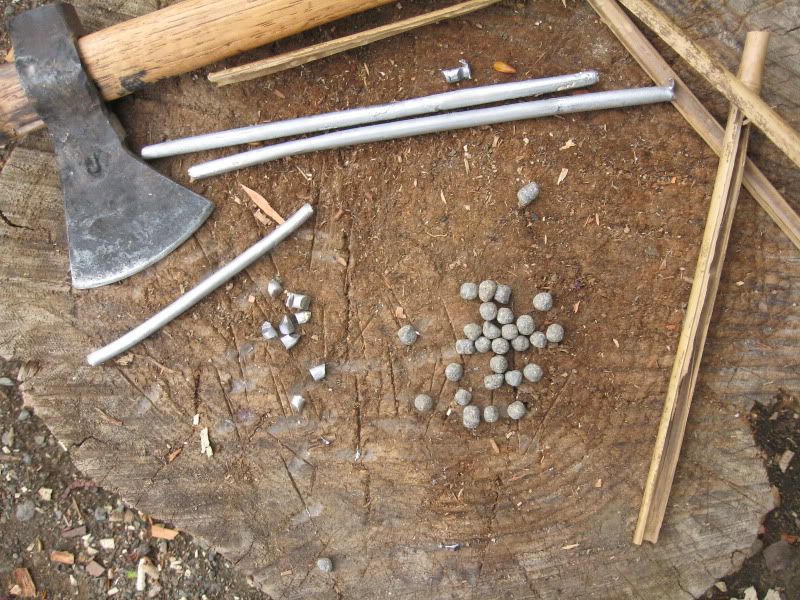You can learn a lot about our colonial period by looking at what they bought and sold. I pay particular attention to the guns, the accoutrements and supplies offered in the 18th century, and one of the neatest things I’ve run across is the way they described the sizes of shot offered for their smoothbores. My database begins in 1728, and at that time there was apparently no numerical system for categorizing shot. Instead, they named each size according to the game for which it was appropriate. So, in increasing size, shot was offered as mustard seed shot, bird, dove, pidgeon, partridge, duck, high duck, low duck, goose, turkey, swan, small deer, deer and buck shot.
I know that at some point this quaint system was replaced by the more practical but less charming numerical size scheme, but I didn’t, and don’t, have any idea when that happened. It occurred to me that I might get a clue by looking at advertisements for shot in the newspapers of the day, so I searched every offering from 1728 to 1763, several thousand hits, looking for the first numbered shot offered for sale. I was about to give up when I found this:
The Pennsylvania Gazette
Date: December 21, 1758
Imported in the ship Myrtilla, from London, and to be sold by SAMUEL HUDSON,
.... ink powder, cutlary, S.B. No. 1, 2, 3 and 8 shot.
Not quite sure if that was what I was looking for, I kept looking and came to this one:
The Pennsylvania Gazette
Date: July 3, 1760
Title: Just imported in the last vessels from London
.... best long narrow back Pennsylvania scythes, bar lead, mustard seed, pidgeon, duck and swan shot, gun flints, F and FF gunpowder, 4 and an half, 4, 12, 11, and 10 shot , White and lilliken pins, ....
Not sure about that one, but then this one:
The Pennsylvania Gazette
September 30, 1762
Imported in the last Vessels from London, Liverpool and Bristol...
.... frying pans, No. 1, 2, 3, 4, 5 and B shot , sad irons....
And one last one:
Publication: The Pennsylvania Gazette
Date: September 22, 1763
Title: To be SOLD by RICHARD WALN, jun.
.... flat irons, swan, duck, No. 1, 2 and 3 shot, F and FF gunpowder, oil flints , copper tea kettles....
I have no idea how long it took to discard most of the named shot, but Ezekial Baker still used the terms for some British shot as late as 1821:
Shot Name---Pellets/Oz.
Buckshot-------5
Ditto small------7
Grape Musket----9
Swan----------15
Goose---------24
Duck----------34
BB------------50
B-------------72
No.1----------94
2------------120
3------------140
4------------175
5------------240
6------------260
7------------320
8------------622
9------------900
10----------1600
Dust---------4300
Maybe they had used both systems all along, as in the ads which offered both. Don't know how you could ever find that out. Whatever, at least some of the names stuck around for a long time, we still use the term "buck" to describe shot, today.
Spence
I know that at some point this quaint system was replaced by the more practical but less charming numerical size scheme, but I didn’t, and don’t, have any idea when that happened. It occurred to me that I might get a clue by looking at advertisements for shot in the newspapers of the day, so I searched every offering from 1728 to 1763, several thousand hits, looking for the first numbered shot offered for sale. I was about to give up when I found this:
The Pennsylvania Gazette
Date: December 21, 1758
Imported in the ship Myrtilla, from London, and to be sold by SAMUEL HUDSON,
.... ink powder, cutlary, S.B. No. 1, 2, 3 and 8 shot.
Not quite sure if that was what I was looking for, I kept looking and came to this one:
The Pennsylvania Gazette
Date: July 3, 1760
Title: Just imported in the last vessels from London
.... best long narrow back Pennsylvania scythes, bar lead, mustard seed, pidgeon, duck and swan shot, gun flints, F and FF gunpowder, 4 and an half, 4, 12, 11, and 10 shot , White and lilliken pins, ....
Not sure about that one, but then this one:
The Pennsylvania Gazette
September 30, 1762
Imported in the last Vessels from London, Liverpool and Bristol...
.... frying pans, No. 1, 2, 3, 4, 5 and B shot , sad irons....
And one last one:
Publication: The Pennsylvania Gazette
Date: September 22, 1763
Title: To be SOLD by RICHARD WALN, jun.
.... flat irons, swan, duck, No. 1, 2 and 3 shot, F and FF gunpowder, oil flints , copper tea kettles....
I have no idea how long it took to discard most of the named shot, but Ezekial Baker still used the terms for some British shot as late as 1821:
Shot Name---Pellets/Oz.
Buckshot-------5
Ditto small------7
Grape Musket----9
Swan----------15
Goose---------24
Duck----------34
BB------------50
B-------------72
No.1----------94
2------------120
3------------140
4------------175
5------------240
6------------260
7------------320
8------------622
9------------900
10----------1600
Dust---------4300
Maybe they had used both systems all along, as in the ads which offered both. Don't know how you could ever find that out. Whatever, at least some of the names stuck around for a long time, we still use the term "buck" to describe shot, today.
Spence







